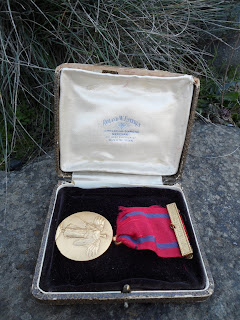It is a WW1 US Victory Medal, with a Transportation Bar, and the ribbon from a New York State Militia Long and Faithful Service Medal. Very unique, and I believe, an authentic, veteran modified, medal from WW1. Here is the "story" as I see it, as told by the "clues". But first, let's look at some details.
When I purchased this medal, it came in the old jewelry box, in the condition you see here.
The jewelry box has the name of a very prominent and respected jeweler of the time, Roland W. Esterly, of Duluth Minnesota.
Roland Esterly opened up his jewelry store in 1918 and continued to do business there, at least, well into the 1920's, if not longer. His name and associated business is referenced more than once in the old journals as one of the top jewelers of the city.
 |
| From NY State Militia Div. of Naval & Military Affairs. |
The ribbon on the medal is from a New York State Militia Long and Faithful Service Medal. Originally this medal would have been issued to a militia member after serving for a set number of years, and then "retiring". New York had a State Naval Militia as well as land forces at the time of WW1 (they still do in fact!). The original medal would have been suspended on a neck ribbon. There was a small "year" charm that the the neck ribbon passed through. (These old medals with neck ribbons and the year charms, are now obsolete, and no longer issued or allowed to be worn).
The Transportation bar at the top of the medal ribbon would have originally been a "Slide On" device and not sewn in place. There also appears to be a professionally drilled hole on the middle, bottom edge, of the bar, with a small suspension ring. This hole was added later, after the Victory Medal was awarded.
The Transportation bar was added to the WW1 Victory Medal for veterans who served on board transportation or cargo ships, and made at least one trip across the Atlantic, between April 6, 1917 and November 11, 1918.
Now, here is my version of the medal's story, as told by my research and clues. Mind you, it is only a "best guess and explanation" based on the medal itself, and my research, but I feel it is probably correct.
The original veteran was a long-time member of the New York State Naval Militia at the time WW1 broke out. When the US went to war, the NY Naval Militia members were transferred to the US Navy. This veteran then served his time aboard a US Navy ship and after the war was over, he was awarded the US WW1 Victory Medal with Transportation Bar for his service in the Atlantic. At some point after the war, he was awarded the New York State Militia Long and Faithful Service Medal and ribbon, with the associated year charm. It was normal for WW1 veterans to wear their medals to civic events, on formal occasions, parades, etc., after they left military service. It is my guess that the veteran had the jeweler in Duluth, Minnesota, combine his two medals into one WW1 service medal.
The Jeweler used the neck ribbon from the New York Militia medal, the medal from the WW1 Victory Medal, and the Transportation slide from the Victory Medal as well. The Transportation bar was drilled and the "year charm" from the Militia Medal was then suspended from it. The Transportation bar was then sewn in place at the top of the newly created medal.
In the years since the "New Medal" was created, the charm was lost, but the suspension ring and bar with hole remained.
The back side of the medal is quite worn and polished on the high points, lending credence to the story that the veteran wore this medal regularly after the war. Since the medal was such a treasured item, it was preserved in the box that the jeweler had provided with it, all of these years.
I wish I knew the actual veteran's name and his individual story, but at least we have this amazing little medal and the story it suggests.
Here is the medal (or medals?). Enjoy.


















No comments:
Post a Comment